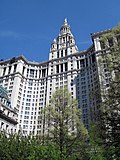Firehouse, Engine Company 31 | |
 (2006) | |
 | |
| Location | 87 Lafayette Street Manhattan, New York City |
|---|---|
| Coordinates | 40°43′02″N74°00′5″W / 40.71722°N 74.00139°W |
| Built | 1895 |
| Architect | Napoleon Le Brun & Sons |
| NRHP reference No. | 72000870 [1] |
| NYCL No. | 190 |
| Significant dates | |
| Added to NRHP | January 20, 1972 |
| Designated NYCL | January 18, 1966 |
Firehouse, Engine Company 31 is a historic fire station located at 87 Lafayette Street between Walker and White Streets in the Tribeca and Civic Center neighborhoods of Manhattan in New York City. It was built in 1895 and designed by architects Napoleon LeBrun & Sons, who styled it after early-16th-century chateaux in the Loire Valley of France. [2] [3] [4]
Contents
The building was designated a New York City Landmark in 1966 and added to the National Register of Historic Places in 1972. The New York City Fire Department vacated the building in November 1972, and it is currently occupied by the Downtown Community Television Center (DCTV). [5]

